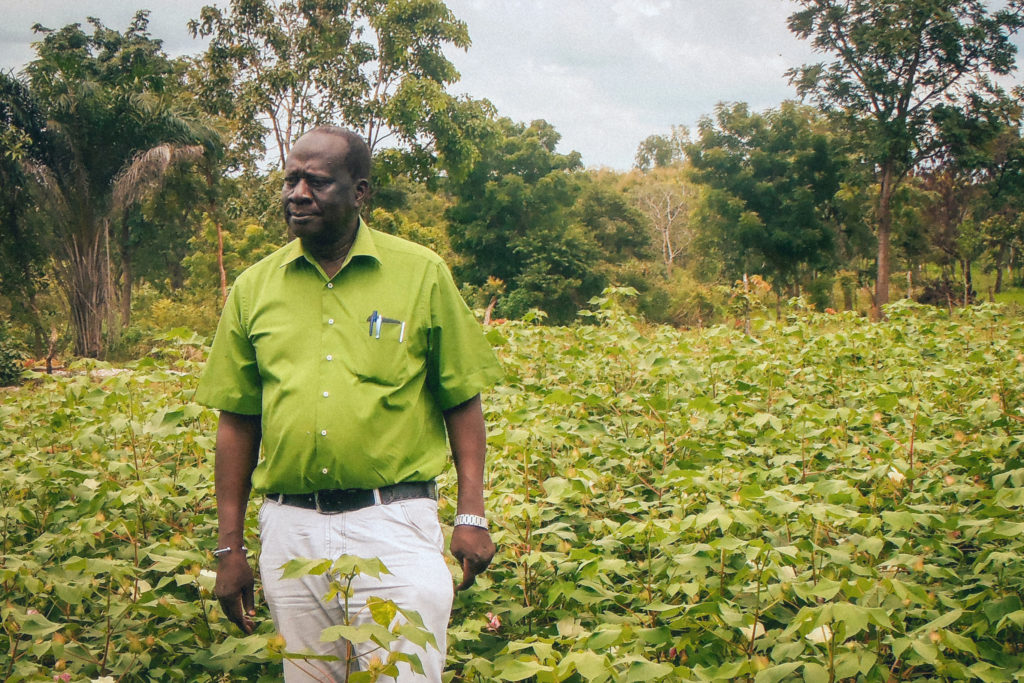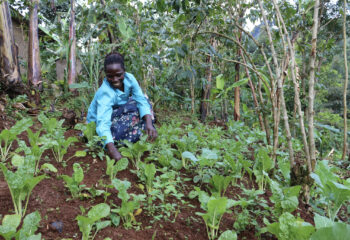
In honor of World Food Day 2021, we interviewed Dr. André Bationo on the transformation of our planet’s food systems. Dr. Bationo was recently listed as one of Devex’s “6 African food security experts to watch.” He serves as Chief of Party for IFDC’s Smallholder Agricultural Productivity Enhancement Program in Benin, Burkina Faso, Cameroon, Mali, and Niger. In 2020, Bationo was honored to receive the Africa Food Prize for his work at IFDC on microdosing and warrantage, two fertilizer technology systems that have benefitted the African food systems for an estimated 10 million West African farmers thus far.
1.What is the biggest challenge for our existing food systems?
The biggest challenge for our food systems is food and nutritional insecurity in sub-Saharan Africa (SSA). SSA has been identified as a hotspot for food shortage due to low agricultural yields. Several African countries are food insecure and have persistently been unable to feed their population. Over the past 40 years or so, agriculture production has increased at a rate of 2.5% per year in Africa—compared to 2.9% in Latin America and 3.5% in developing Asia. Currently, Africa is a net food-importing region. Food imports in Africa amount to about $100 billion* per year. The number of chronically undernourished people increased from 168 million in 1990-1992 to 194 million in 1997-1999.
Today, Africa, with 250 million undernourished people, is second only to Asia (FAO). Agricultural productivity in Africa lags behind all other continents. Cereal crop yields in Asia, for instance, have doubled or quadrupled since the 1960s, but have have stagnated in Africa. While populations have increased, food production per capita has been declining in Africa for the past three decades. African families face increasing challenges to feeding themselves and their children. Malnutrition remains shockingly common in Africa, especially among children, as the nutritional quality of food is not often assured. This malnutrition has negative consequences not only on children’s health but also on their cognitive abilities.
*All currencies are in USD unless otherwise noted
2. Why is food insecurity on the rise and what can be done to tackle it?
Soil infertility remains the fundamental biophysical cause for the declining per capita food production in SSA over the last three to five decades. This is evident from the huge gap between actual and potential crop yields (read: “Soil Nutrients: The Key to Meeting the Triple Global Challenge of Food and Nutrition Security, Climate, and Biodiversity”).
Development of the modern fertilizer industry had a tremendous positive impact on agricultural productivity and global food security, and it is widely acknowledged that fertilizers are responsible for at least half of the global food supply. Table 1 shows the yield of selected crops in farmers’ fields without the use of fertilizers as compared to the potential yields obtained on-station with the use of fertilizers. It is evident that for some crops it is possible to increase the yield up to five times by improving soil nutrients and applying good agronomic practices. (https://ifdc.org/2020/12/09/ifdc-and-ecowas-bank-for-investment-and-development-ebid-collaborate-to-improve-soil-health-in-west-africa/ )
| Crop | Actual Yield from Farms without Fertilizer(kg/ha) | Potential Yield On-Station with Fertilizer (kg/ha) | Increase over Control (%) |
|---|---|---|---|
| West Africa | |||
| Irrigated rice | 3,000 | 8,000 | 167 |
| Upland rice | 1,000 | 4,000 | 500 |
| Cassava | 8,000 | 47,000 | 487 |
| Maize | 800 | 6,000 | 650 |
| Sorghum | 600 | 3,000 | 400 |
| Millet | 300 | 2,000 | 567 |
| East Africa | |||
| Maize | 1,500 | 8,000 | 433 |
| Southern Africa | |||
| Maize | 1,500 | 8,000 | 433 |
Table 1. Yield potential with fertilizer use in Africa
SSA uses 8 kg per hectare of NPK, the lowest in the world (the world average is 100 kg per hectare of NPK). The consumption of fertilizer per capita is five time higher in Asia as compared to SSA.
The data in table 1 demonstrates the need to work with smallholder farmers to realize potential yields within the context of integrated soil fertility management—adoption of good agronomic practices; higher, targeted application of both mineral and organic fertilizers; and use of improved seeds—while protecting the environment.
The low use of fertilizers has caused crop yields to stagnate during the past 50 years. This has led to food insecurity and, as farmers increase land area under cultivation, deforestation. The good news is, Africa has considerable fertilizer resources at its disposal. Seventy percent of the world’s total phosphate rock resources, as well as significant deposits of nitrogen and potash resources, can be found on the continent.
Lack of inclusivity in agriculture value chains, poor infrastructure and market linkages, and limited use of good agricultural practices—including appropriate fertilizer use—have greatly contributed to food insecurity. This is compounded by climate change, characterized by longer drought periods, floods, more erratic rainfall, and increased incidences of disease and pest attacks. More effort is needed to build resilience through systematic approaches that look at entire value chains to address gender inclusiveness and women empowerment, strengthen farmer organizations, and promote adoption of climate-smart agricultural practices.
Solutions to food insecurity are also dependent upon good governance, the implementation of good policies (national and regional), and investments in agricultural transformation, including industrialization, to provide healthy and nutritious food.
3. What impact is climate change having on food systems and how can this be mitigated?
Climate change brings threats arising from stresses and shocks caused by higher temperature and erratic rainfall. The potential yield loss to climate change impact is about 5% for each degree Celsius of global warming. Indeed, recent studies report that yields for many crops are expected to decline because of climate variability and long-term changes in temperature and rainfall. The outcome may be higher food prices along with chronic poverty and undernutrition for farming households already struggling with climate extremes, such as drought and flood.
Fertilizer is commonly thought to increase risks in dryland farming, but in some situations, it may be risk-neutral or even risk-reducing. Phosphorus and shorter-duration millet varieties in Niger, for example, cause crops to grow hardier and mature earlier, reducing damage from and exposure to drought.
In the dry land of the Sahel, several scientists have reported that where rainfall exceeds 300 mm, the most limiting factor for crop production is soil nutrients, not water. In Sadore, Niger, where the annual average rainfall is 560 mm, the lack of fertilizer use resulted in a harvest of only 1.24 kg of pearl millet grain per millimeter of water. In contrast, where fertilizers were used appropriately, farmers were able to harvest 4.14 kg of millet grain per millimeter of water (Table 2).
| Treatment | Sadore | Dosso | ||||||||
| WU (mm) | Y (kg ha-1) | WUE | WU (mm) | Y (kg ha-1) | WUE | |||||
| With fertilizer | 382 | 1,570 | 4.14 | 400 | 1,700 | 4.25 | ||||
| Without fertilizer | 373 | 460 | 1.24 | 381 | 780 | 20.4 |
Table 2. Water use (WU), grain yield (Y), and water use efficiency (WUE) for millet at Sadore and Dasso (Niger)
Many development projects have invested billions of dollars in soil and water conservation. Soil fertility improvement was not included in these projects, and the water harvested has not fulfilled its full potential for productivity improvement. Fertilizers are a critical component of improved water use efficiency, as water harvesting can also improve the fertilizer use efficiency. The Zai system, in which farmers dig pits in the soil to capture water and concentrate fertilizers, is widely used in West Africa for water harvesting and soil conservation. As shown in Table 3, when the Zai technique omits compost and/or fertilizers, it does not contribute significantly to productivity (200 kg ha-1of sorghum grain). When Zai includes manure and fertilizer, significant crop yield increases can be obtained (1,700 kg ha-1 of sorghum grain).
| Technology | Sorghum Yield (kg ha-1) | Yield Increase (%) |
|---|---|---|
| Only planting pits (Zai) | 200 | – |
| Zai + cattle manure | 700 | 250 |
| Zai + mineral fertilizers | 1400 | 600 |
| Zai + cattle manure and fertilizers | 1700 | 750 |
Table 3. Effect of Zai on sorghum yields
A climate-smart agriculture (CSA) approach can greatly mitigate the adverse effect of climate change. In the northern part of Burkina Faso in the Sahel region, rainfall variability, land degradation, and desertification combine to make life extremely difficult. The combination of water harvesting, microdose mineral fertilizer application, and use of improved sorghum varieties have significantly increased grain yield.
Read: Microdosing: Boosting Yields and Producing Hope in the Town of Beer
When an improved sorghum variety is used with water harvesting, in combination with microdose mineral fertilizer application, an average yield of 1,426 kg/ha can be obtained, as compared to 334 kg/ha with no water harvesting or microdose fertilizer application (Table 4).
| Treatment | Local Variety | Improved Variety |
|---|---|---|
| No water harvested and no microdose fertilizer applied | 360 | 334 |
| Water harvested and no microdose fertilizer applied | 447 | 862 |
| No water harvested and no microdose fertilizer applied | 598 | 1,022 |
| Water harvested and microdose fertilizer applied | 772 | 1,426 |
Table 4. Effect of water harvesting, fertilizer microdosing application, and crop variety on sorghum grain yield (kg ha-1) in Kouritenga, Burkina Faso
Countries should strengthen and support the growth of institutions that promote CSA. Investments by both public and private sector actors should be increased, particularly to support the input and marketing dealers that supply CSA technology inputs and services.
4. What role can community-led projects and smallholder farmers play in transforming our food systems? Share an example.
Lessons learned in development clearly indicate that results depend very strongly on the successful mobilization, inclusion, and involvement of the communities and smallholder farmers who stand to benefit. Smallholders, including women and youth, should be included in the different stages of projects: identification of needs and mapping exercises, implementation, and monitoring and evaluation. Particular attention should be paid to issues of gender equity and rural land tenure. The role of women is essential in the transformation of food systems. Strong farming community organizations and systematic gender inclusiveness will greatly contribute to this transformation.
Access to appropriate, affordable credit will empower farmers to adopt new technologies and techniques that boost the quality and quantity of their crops. Systems like warrantage provide a kind of social safety net that addresses challenges to financial liquidity and access to credit. Producers can access cash loans against the value of their stored farm produce at harvest when the selling price is relatively low. Farmers can store their grain to sell four to five months later when prices improve, thus earning better returns on their investments and easily repaying the loan. With these loans, farmers can address urgent household financial needs and participate in collective fertilizer purchases, which further lower the cost. With this credit, farmers also can engage in other income-generating activities (raising small ruminants, vegetable gardening, and trading) during the off-season.
Warrantage System Empowers Palm Oil Producers – IFDC
5. How can we make adequate nutrition accessible, affordable, and sustainable, especially for mothers and children in lower- and middle-income countries?
One way is through adoption of crops that are rich in nutrition, e.g., the protein-rich maize varieties and orange-fleshed sweet potato that are being promoted in some countries. Research should focus on producing crop varieties with enhanced nutrients in parallel with adaptation to climate change. Another way is through agronomic fortification and value-added fortification of foods at the processing stage to fill nutrient gaps. But increasing the availability of nutritious foods in home gardens, off-season growing activities, and market access are not enough. Good nutrition requires behavior change at the household and community levels.
Communities should build household awareness of the importance of good nutrition and programs and empower women to make decisions within the household. Women can increase their purchasing power and choose more nutritious foods. Awareness programs should be incorporated in the primary schools, so children grow up knowing the importance of good nutrition.
Improving women’s knowledge and raising awareness of the kinds of nutritious foods available within a community is essential, since women are the basis of food systems, particularly in rural households. Programs to improve household nutrition should consider local food preferences and work with women leaders within the community to incorporate more nutritious foods, including local vegetables and forest products, into existing popular dishes.
Meet the Nutrition Champions: A bridge to healthy and productive local communities
6. What can be done throughout the food chain to optimize production and significantly reduce food waste?
If the goal is to increase productivity along agricultural value chains, any effort at improvements must start with a thorough analysis of the value chain to identify existing gaps and develop local approaches that address them. Programs should be multidisciplinary—include the policymakers, scientists, and private sector—to address the gaps identified. Strengthened private sector linkages will ensure sustainability after the project ends.
Food waste begins in production. By adopting good agricultural practices, farmers ensure that they are producing high-quality products free of pests and diseases. Quality post-harvest storage facilities will reduce further losses to vermin, mold, and rot and allow farmers to safely store their produce to take advantage of higher post-harvest prices. Infrastructure and marketing also play a key role in reducing food wastage. Areas that produce highly perishable food products should be supported with adequate infrastructure to quickly move products to meet demand elsewhere. And rural electrification and use of solar energy will further prevent food waste at the farm level.
Smoking Out Food Loss in Benin—see how the ACMA2 project has been improving food security and reducing food loss.
7. What is your single most important call to action on building more sustainable food systems?
Countries must increase investment in the agriculture sector and implement effective and efficient policies that enable sustainable food production. I would like to see a more effective synergy between researchers, producers, processors, manufacturers, consumers, and decision-makers.
Feed the Future Soil Fertility Technology Adoption, Policy Reform and Knowledge Management Project
About André:

Want to learn even more about Dr. Bationo’s work? Check out his biography here.




